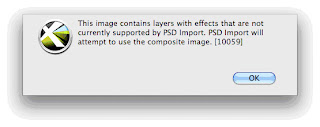"the best integration with Photoshop’s PSD file format of any layout tool available today."Yes, you read that right. This appears in a free PDF on their website, QuarkXPress 8, Xperience Design. So, I thought I’d test the waters and it turns out that the statement is pretty accurate.
There are limitations to what Quark’s PSD import feature can handle so in the help files, there’s a section on preparing PSD files. The key thing is, don’t use any layer styles. If you do, you’ll get the following warning:

Quark will effectively flatten the file and you won’t have access to the layers if you include any effects. You can get around this by converting your effects into layers. Quark also recommends converting Shape layers to Smart Objects for maximum compatibility.
So what can you do with PSD files, once they are imported into Quark? You can turn layer visibility on and off and change the blending mode and opacity.

Unfortunately, you can’t change the order of the layers, add layer masks, or effects to them. However, you can view and work with Channels and Paths that are saved in the PSD file. For example, you might have a Spot Color channel in a file. Let’s say that you decide you want to change the spot color. You don’t have to go back to Photoshop to do that, just double click on the Spot Color channel and choose another color in the palette.

Any changes you make to the PSD file outside of Quark will be indicated by a Red circle in the lower right-hand corner of the PSD Import palette. You won’t need to go to the Usage dialog to update the file, just double click on the red circle.
InDesign has a feature called Object Layer Options for placed PSD files. There’s two things you can do with this, turn layer visibility on and off and choose a Layer Comp, if they are in the file. Here, again, you can’t change the order of the layers but more so, you can’t change the opacity or blending modes on the fly. You can’t get to the Channels or Paths, but InDesign does handle them. In the case of that Spot Channel, the color is added to the Swatches panel and Paths can be used in the Text Wrap panel.
So, as you can see, Quark does have a little bit of a leg up here on the PSD thing, with potentially less trips back to Photoshop for edits. Is it a tighter integration than InDesign? Hmmm. What are your thoughts?
No comments:
Post a Comment